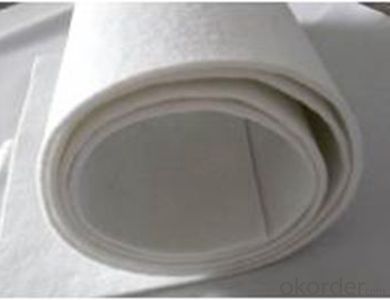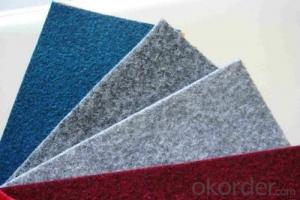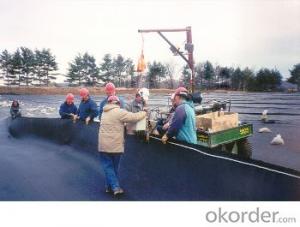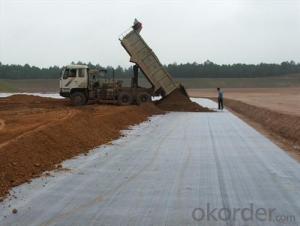Needle Punched Nonwoven Geotextile and High Strength Materials for stabilization
- Loading Port:
- China main port
- Payment Terms:
- TT OR LC
- Min Order Qty:
- 1000 g/m²
- Supply Capability:
- 100000 g/m²/month
OKorder Service Pledge
OKorder Financial Service
You Might Also Like
Item specifice

Nonwoven Geotextile For Highways Road Construction
Applications:We offer a wide range of Non Woven Geotextile Fabrics used while making
Highways and Road Construction. Non Woven Geotextile fabrics are also known as civil
engineering fabrics, erosion control cloth, filter fabrics and support membranes.
RP make Non Woven Geotextile fabrics have their project, structure, or system based on
various geo technical materials such as soils, rock, earth etc. Non Woven Geotextile
fabrics are either used to restrict or allow passage of Water in Slopes and Road
construction, as desired.
The Range of Needle punch Non Woven Geotextile fabrics offered by us are as follows:
Reinforcement
Drainage
Separation
Non-woven geotextile fabrics are primarily used for projects where highly permeable
separators are required. This includes applications that must allow water to flow while
preventing soil erosion or soil loss.
FAQ:
Q: What kind of payments does jenor support?
A: T/T, L/C, Cash are accepted.
Q: Do you charge for the samples?
A: Accordeing to our company policy, the samples are free, we only charge the freight fee. And we will return the freight fee during the next order.
Q: Can you produce according to customers' design?
A: Sure, we are professional manufacturer, OEM and ODM are both welcome.
Q: Do you have other products?
A: Yes, please check the pictures:
- Q:Acupuncture geotextile is divided into several kinds of how is it used?
- Acupuncture geotextile is now divided into two types, according to the fiber form to points. Continuous fiber called filament acupuncture non-woven geotextile. A few centimeters of length fibers made of staple fibers for nonwoven geotextiles. Use is not used, mainly used in geotechnical engineering in the filter, isolation, drainage and so on.
- Q:Geotextile how to do on-site measurement
- Geotextile is calculated by the square, you only need to measure a long, wide, calculate the area will be able to know how much geotextile, and hope to help you!
- Q:How do geotextiles contribute to the stability of landfill slopes?
- Geotextiles contribute to the stability of landfill slopes by providing reinforcement and erosion control. They are placed between different layers of soil to enhance the overall strength and stability of the slope. Geotextiles help to distribute the loads more evenly, preventing excessive settlement and potential slope failure. Additionally, they reduce soil erosion by acting as a barrier against water flow, thus protecting the slope from erosion and maintaining its stability over time.
- Q:What are the specifications for geotextiles in landfill liner applications?
- The specifications for geotextiles in landfill liner applications typically include factors such as weight, thickness, puncture resistance, and permeability. The geotextiles used in landfill liners should have a high tensile strength to withstand the stress of the landfill waste, a thickness that provides sufficient barrier against punctures, and a permeability that allows for proper drainage of leachate. Additionally, they should meet certain industry standards and regulations to ensure their effectiveness in containing waste and protecting the environment.
- Q:What are the key differences between woven and nonwoven geotextiles?
- Woven geotextiles are made by weaving individual threads together to create a strong and durable fabric, while nonwoven geotextiles are made by bonding fibers together using heat, chemicals, or mechanical processes. Woven geotextiles have high tensile strength and are commonly used for soil stabilization, erosion control, and separation of different soil layers. On the other hand, nonwoven geotextiles have excellent filtration and drainage properties, making them suitable for applications such as filtration, separation, and protection. Overall, the key differences between woven and nonwoven geotextiles lie in their manufacturing process, physical properties, and intended usage.
- Q:What are the advantages of using geotextiles in wetland restoration projects?
- There are several advantages of using geotextiles in wetland restoration projects. Firstly, geotextiles provide effective erosion control by stabilizing the soil and preventing it from washing away during heavy rainfall or flooding. This helps in maintaining the wetland's structure and preventing further degradation. Secondly, geotextiles act as a barrier, preventing the migration of harmful substances such as pollutants or excess nutrients from adjacent areas into the wetland, thus protecting its ecological integrity. Additionally, geotextiles can enhance vegetation growth by retaining moisture in the soil, promoting root development, and preventing weed growth. This ultimately contributes to the overall success of wetland restoration efforts.
- Q:What are the factors that affect the effectiveness of geotextiles in erosion control?
- The effectiveness of geotextiles in erosion control is influenced by several factors. Firstly, the material and quality of the geotextile itself play a significant role. Geotextiles with higher tensile strength and durability are more effective in preventing erosion. Secondly, the design and installation of the geotextile are crucial. Proper placement and anchoring techniques ensure that the geotextile remains in place and functions effectively. The type and intensity of the erosive forces also impact the effectiveness of geotextiles. Factors such as water flow rate, soil type, slope gradient, and vegetation cover can affect how well the geotextile mitigates erosion. Additionally, the maintenance and regular inspection of the geotextile are important for its long-term effectiveness. Overall, a combination of material quality, proper installation, and consideration of site-specific conditions contribute to the effectiveness of geotextiles in erosion control.
- Q:How do geotextiles affect soil moisture retention?
- Geotextiles can significantly impact soil moisture retention by acting as a barrier between the soil and the external environment. They help in reducing excessive evaporation from the soil surface, thus minimizing water loss. Additionally, geotextiles prevent the erosion of soil particles, maintaining soil structure and facilitating better water infiltration. This ultimately improves soil moisture retention by creating a more favorable and stable environment for plants to grow.
- Q:What are the environmental impacts of using geotextiles?
- Geotextiles can have both positive and negative environmental impacts. On the positive side, they can help prevent soil erosion, improve water quality by filtering pollutants, and promote vegetation growth. Additionally, they can reduce the need for chemical treatments and provide a sustainable alternative to traditional construction materials. However, geotextiles are typically made from synthetic materials like polyester or polypropylene, which are derived from non-renewable resources and can release microplastics into the environment. Moreover, the production and disposal of geotextiles can contribute to greenhouse gas emissions and waste generation. Therefore, careful consideration of the environmental trade-offs is necessary when using geotextiles.
- Q:Geotextile geomembrane factory need to record, certificate, inspection report?
- Do not need to see if the time is not your company's chapter to know ah
1. Manufacturer Overview |
|
|---|---|
| Location | |
| Year Established | |
| Annual Output Value | |
| Main Markets | |
| Company Certifications | |
2. Manufacturer Certificates |
|
|---|---|
| a) Certification Name | |
| Range | |
| Reference | |
| Validity Period | |
3. Manufacturer Capability |
|
|---|---|
| a)Trade Capacity | |
| Nearest Port | |
| Export Percentage | |
| No.of Employees in Trade Department | |
| Language Spoken: | |
| b)Factory Information | |
| Factory Size: | |
| No. of Production Lines | |
| Contract Manufacturing | |
| Product Price Range | |
Send your message to us
Needle Punched Nonwoven Geotextile and High Strength Materials for stabilization
- Loading Port:
- China main port
- Payment Terms:
- TT OR LC
- Min Order Qty:
- 1000 g/m²
- Supply Capability:
- 100000 g/m²/month
OKorder Service Pledge
OKorder Financial Service
Similar products
New products
Hot products
Related keywords

































